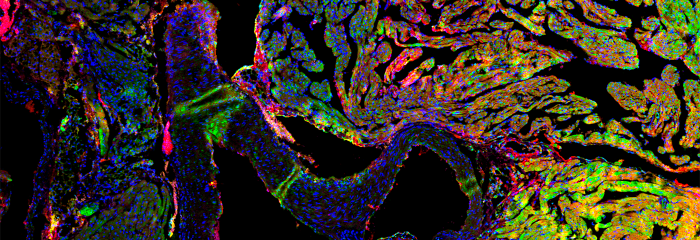
BME Molecular & Cellular Engineering
Cornell biomedical engineers implement multidisciplinary and multi-scale strategies that combine advanced high resolution imaging, biophysics, microfabrication, genetic modifications, protein engineering, and quantitative modeling to analyze and manipulate cell and molecular dynamics and interactions.
We are motivated by the goal of uncovering the details of normal cell functions and disease processes, improve diagnostics, and develop novel therapeutic approaches. Cornell’s world-class expertise and resources include: the Cornell NanoScale Science & Technology Facility (CNF), the Cornell Center for Immunology, the Biotechnology Resource Center, the Cornell Physical Science Oncology Center, and Cornell’s top-ranked veterinary school and medical school synergize to create an ideal environment for research in Molecular and Cellular Engineering.
Faculty research interests

Ilana Brito
Ilana Brito’s lab is developing precision medicine approaches to alter deleterious functions within the human microbiome. We envision live bacterial therapeutics that can alter microbiome involvement in atherosclerosis, inflammation and to ensure the efficacy of other treatments that the microbiome may affect. We also use a variety of techniques to explore microbiome function, including high throughput sequencing and algorithm development, genetic engineering, synthetic biology, and single-cell methods.

Jonathan Butcher
Jonathan Butcher’s group studies how microenvironmental cues govern the transdifferentiation of heart valve cells towards osteogenic lineages, and identify principle mechanobiological pathways to target for molecular therapies to delay or rescue valve calcification. The Butcher lab also investigates the molecular regulation of embryonic valvular progenitor maturation and uses this program to engineer autologous valvular phenotypes for regenerative medicine applications.

Nate Cira
Nate Cira’s lab uses fluidic tools and sequencing to understand how the genome acts as the fundamental set of biological instructions. This effort involves discovering novel microbes and is enhanced by the Lab’s work on high throughput experimental systems.

Ben Cosgrove
Ben Cosgrove’s lab studies how muscle stem cells interpret and process microenvironmental information through signaling networks that govern their cell fate during tissue maintenance and repair. Inspired by these regulatory insights, his lab engineers molecular features into self-assembled and micro-fabricated 3D biomaterials to enhance stem cell contributions to muscle regeneration.

Iwijn De Vlaminck
Iwijn De Vlaminck’s research focuses on the development of molecular analysis technologies for microbiology and immunology and the application of these technologies in the monitoring of infectious diseases and immune-related complications. His research is highly interdisciplinary in nature, and requires innovation in genomics, computational biology and molecular engineering.

Claudia Fischbach
Claudia Fischbach’s lab studies the role of cell-microenvironment interactions in the development, progression, and therapy resistance of cancer. In particular, her group integrates microfabrication and tissue engineering strategies to test the impact of extracellular matrix composition, structure, and mechanical properties on tumor angiogenesis, stroma remodeling, and bone metastasis.

Jan Lammerding
Jan Lammerding’s laboratory is using a combination of microfabrication, time-lapse microscopy, and stem cell biology to create in vitro models of skeletal and cardiac muscle to study how mutations in nuclear envelope proteins cause muscular dystrophies and heart disease, and how cells translate mechanical stimuli into biochemical signals. In addition, the Lammerding lab is applying cell and molecular engineering approaches to investigate how changes in nuclear structure and mechanics can modulate cell migration in 3-D environments and facilitate cancer metastasis.

Esak (Isaac) Lee
Esak (Isaac) Lee’s lab focuses on lymphatic vascular biology, cancer biology, immunoengineering, and regenerative medicine. To address key questions in these fields, Dr. Lee develops novel organs-on-chip platforms mimicking lymphatic drainage, tumor vascular interactions, and immune cell trafficking to the vasculatures to provide new strategies for regenerative medicine and treatment of cancer, immune diseases, and edema.

Karl Lewis
Karl Lewis’s lab combines custom engineering and cutting edge imaging techniques to research the way musculoskeletal cells use mechanical forces for biological processes. They are presently using multiphoton microscopy to investigate changes in osteocyte mechanobiology in health and disease with the goal of identifying novel therapeutic targets. Additionally, the Lewis Lab is developing a novel technique for investigating bone-cartilage mechanotransduction events in live animals, a powerful tool for understanding joint disease.

Krystyn Van Vliet
Krystyn Van Vliet’s lab specializes in material chemomechanics – the coupling between chemistry and mechanics at material interfaces. Applications include optimizing materials for renewable energy and developing new materials and methods for cell therapies and drug screening.

Kayla Wolf
Kayla Wolf’s group addresses clinical needs in kidney and women's reproductive health by developing models of urogenital tract tissues and investigating biophysical forces that direct tissue function.
BME Graduate Field Faculty in Molecular & Cellular Engineering
Christopher Alabi, caa238@cornell.edu
Matt DeLisa, md255@cornell.edu
David Erickson, de54@cornell.edu
Monica Guzman, mlg2007@med.cornell.edu
Chun Han, chun.han@cornell.edu
Ailong Ke, ak425@cornell.edu
Brian Kirby, bk88@cornell.edu
Dan Luo, dl79@cornell.edu
Alexander Nikitin, an58@cornell.edu
Chris Ober, cko3@cornell.edu
Matthew Paszek, mjp31@cornell.edu
Lois Pollack, lp26@cornell.edu
Shu-Bing Qian, sq38@cornell.edu
Heidi Reesink, hlr42@cornell.edu
Robert E. Schwartz, res2025@med.cornell.edu
Mingming Wu, mw272@cornell.edu
Rong Yang, ryang@cornell.edu

